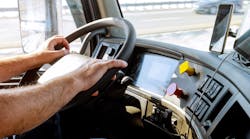The top officials at the National Highway Traffic Safety Administration (NHTSA) and Federal Highway Administration (FHWA) are touting advanced driver assistance systems (ADAS) and automated driving systems (ADS) technologies as part of the solution to improve safety for commercial vehicle operations.
During the Federal Motor Carrier Safety Administration’s (FMCSA) virtual Trucking Safety Summit, James Owens, acting administrator of NHTSA, pointed out that in 2018, there were 4,415 fatal crashes involving large trucks, with 885 truck occupants killed. In those fatal crashes, however, the majority of those killed were occupants of other vehicles, as well as pedestrians, cyclists, and other road users.
“We believe technology can and will play a large role in preventing crashes and saving lives,” Owens said. “Many manufacturers are rolling out new advanced driver assistance systems in passenger vehicles. Examples include automatic emergency braking and lane-keeping assistance, which can help drivers avoid crashes and reduce the severity of crashes that do occur.”
“NHTSA is conducting several studies to determine how ADAS technology will benefit heavy trucks,” he added. “We are nearing completion of a research study that explores the safety benefits of ADAS for heavy vehicles.”
NHTSA is also in phase two of field operational testing of a new generation of ADAS features for heavy vehicles. That includes blind-spot warning, forward-collision warning, lane-departure warning, and automatic emergency braking.
In addition, NHTSA is working to issue a final rule later this year that would allow truck and motor vehicle manufacturers the option to install adaptive driving beam headlamps, Owens said. This headlamp uses automated technology to provide more light for drivers and identifies and shades certain targets from the upper beam headlamps, he added.
NHTSA is also researching a rulemaking related to the safe development of testing of ADS, Owens said.
“We are implementing a project related to the production of ADS and ADAS in heavy vehicles,” he explained. “This project will identify a variety of design and operational considerations with implementing ADS and ADAS technologies on commercial vehicles.”
Nicole Nason, FHWA administrator, emphasized that the COVID-19 pandemic has highlighted the demand for e-commerce and just-in-time delivery services, which is expected to grow in the years ahead.
“The American trucking industry is carrying more goods on U.S. roads now than ever before, estimated to be around 12 billion tons in 2018, valued at nearly $11 trillion,” Nason said. “These numbers are expected to continue to climb to 14.2 billion tons, worth more than $16 trillion in the next 25 years.”
She added that new technologies are part of the solution to making freight move more efficiently and safely.
“Safer roads for everybody is the result of expanded truck parking availability, as well as improved electronic routing systems and weigh-in motion scales,” Nason said. “We know truck parking shortages are still a major transportation safety problem. This is true nationwide, with implications for the safety of everyone on the highways—not just the women and men who drive trucks, but motorists as well.”
FHWA has provided funding, developed truck parking capacity and truck parking information systems to inform truck drivers about parking availability, Nason said. The agency is also encouraging states to implement automated permitting systems for the issuance of blanket permits and emergency permits to help expedite oversized or overweight vehicles needed in emergencies.




